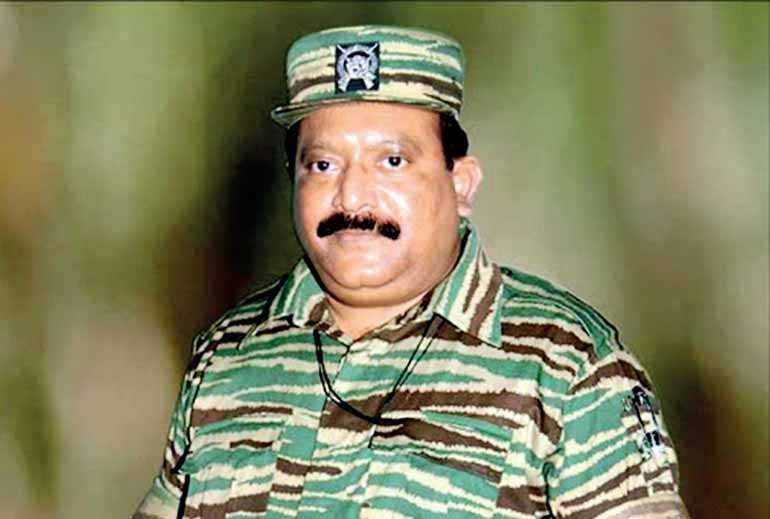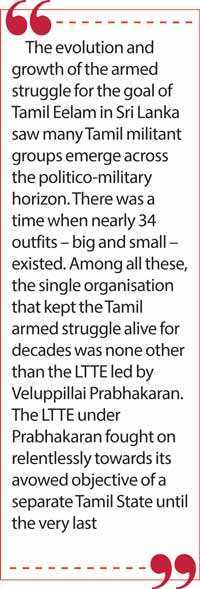Monday Apr 14, 2025
Monday Apr 14, 2025
Wednesday, 19 May 2021 00:10 - - {{hitsCtrl.values.hits}}

The successful growth of the LTTE led by Veluppillai Prabhakaran came at huge cost to the Tamil people of Sri Lanka. Vertically the LTTE ascended, but horizontally the Sri Lankan Tamils descended. This was the unpleasant and inconvenient truth that the LTTE and acolytes often denied
 Forty-five years ago on 5 May 1976, a section of militant Tamil youths in northern Sri Lanka re-grouped themselves into an organisation called the Liberation Tigers of Tamil Eelam (LTTE).
Forty-five years ago on 5 May 1976, a section of militant Tamil youths in northern Sri Lanka re-grouped themselves into an organisation called the Liberation Tigers of Tamil Eelam (LTTE).
The LTTE, which became popularly known as the Tiger organisation, had as its fundamental objective the setting up of a separate Tamil state on the island through armed struggle. Thereafter the Tigers engaged in armed confrontation against the Sri Lankan State for several decades.
The LTTE developed into a powerful militia that adopted positional warfare and was capable of capturing, retaining and defending extensive territory. The Tigers were also perceived as the determining force in Sri Lankan politics for many years.
Thirty-three years later in mid-May 2009, the LTTE suffered a total military defeat at the hands of the Sri Lankan armed forces in the Mullaitivu District of Sri Lanka’s Northern Province. Prior to that the armed forces had been steadily advancing and compelling the LTTE to retreat gradually despite the tenacity of Tiger resistance.
Four days in May, 15 to 18 May, were of crucial importance in this respect. The long war came to an end on 18 May followed by the official announcement of LTTE Leader Thiruvengadam Veluppillai Prabhakaran’s demise on 19 May 2009. His body was recovered on the banks of the Mullaitivu lagoon known as Nandikadal.
It could be seen, therefore, that the month of May has proved to be of great significance in the Tamil armed struggle for Tamil Eelam spearheaded by the LTTE known as the Tigers. It is against this backdrop that this column focuses this week on the rise and fall of the LTTE. Most readers know that I have been writing extensively on the LTTE for many years in the past. I shall be re-visiting some of my earlier writings in this two-part article about the LTTE and its supremo Prabhakaran.
Prabhakaran’s early life
The evolution and growth of the armed struggle for the goal of Tamil Eelam in Sri Lanka saw many Tamil militant groups emerge across the politico-military horizon. There was a time when nearly 34 outfits – big and small – existed.
Among all these, the single organisation that kept the Tamil armed struggle alive for decades was none other than the LTTE led by Veluppillai Prabhakaran. The LTTE under Prabhakaran fought on relentlessly towards its avowed objective of a separate Tamil State until the very last.
Prabhakaran was born on 26 November 1954. He was the youngest in a family of two boys and two girls. Since he was the youngest, Prabhakaran’s pet name was “Thambi” or younger brother. His father was Veerasamy Thiruvengadam Veluppillai while his mother was Paarvathipillai. Prabhakaran’s family hailed from the coastal town of Valvettithurai, generally referred to as VVT. Prabhakaran’s family was of respected lineage in VVT known as the “Thirumeni kudumbam” or Thirumeni family. Prabhakaran’s ancestors constructed the famous Sivan Temple of VVT.
As a schoolboy, Prabhakaran, like most youngsters of his age was fond of cycling and playing volley ball and soccer. But he was no sportsman and preferred to read or watch action films. Another pursuit in boyhood was the targeting of squirrels, lizards, chameleons and small birds with a catapult. As a kid, Prabha would prowl about areas of dense vegetation searching for his quarry.
His memory power was legendary. Prabhakaran would remember faces, names and the last time he had seen someone years ago. His eyes were always sharp and roving taking in the surrounding area and ever on the alert. As his eyes were large and striking, Prabhakaran was teased as “muliyan” (goggle-eyed).
Prabhakaran’s attitude and political thinking was shaped by contemporary events and environment. The gruesome tales he heard as a four-year-old child about the 1958 anti-Tamil violence impacted greatly. One day, Prabhakaran’s home had a female visitor whose legs were scarred by burns. Upon inquiring, the little boy was told that the woman’s home had been set on fire by a “Sinhala” mob. She had escaped with burns. Young Prabha also heard the famous story of the Brahmin priest in Panadura being burnt to death in a bonfire, and also about the infant thrown into a tar barrel. All these tales made an indelible impression.
Being a native of Valvettithurai was another factor in making a militant out of Prabhakaran. VVT had acquired a reputation for smuggling and had a sub-culture of its own. ‘Operation Monty’ was launched by the armed forces in post-independence Sri Lanka to check and counter illicit immigration and smuggling. This necessitated the setting up of security camps in VVT from the early fifties of the last century. There was much friction as a result of this military presence.
This in turn led to a confrontational mood prevailing between the people and armed forces long before the political crisis escalated in the seventies. It was in this environment that Prabhakaran and a host of other VVT youth grew up in Valvettithurai with anger and resentment towards the armed forces and by extension the Government in Colombo held responsible.
Political motivation
Prabhakaran growing up in this atmosphere got politically motivated in the late sixties and early seventies of the previous century. This was when former Kayts MP V. Navaratnam broke away from the Ilankai Thamil Arasu Katchi (ITAK) known as Federal Party (FP) in English.
Navaratnam once described as the “golden brain” of the FP formed the ‘Thamizhar Suyaatchi Kazhagham’ or Tamil self-rule party in 1968. Navaratnam abandoned the federal demand as being too little and too late and instead opted for ‘Suyaatchi’ or “self-rule” – a euphemism of sorts for a separate state.
There was a pedagogue named Venugopal Master in VVT for whom Prabhakaran had great regard and respect. Venugopal Master became an active supporter of Navaratnam. Several students, including Prabhakaran became his followers and turned into ardent devotees of Tamil self-rule.
The Suyaatchi Kazhagham also started a newspaper, ‘Viduthalai’ (Liberation/Freedom). Navaratnam himself translated and serialised ‘Exodus,’ the famous novel written by Leon Uris. It was named ‘Namakkendroru Naadu’ (‘A Country of Our Own’); young Prabhakaran eagerly devoured it and became hooked on the dream of a country for Tamils. The Tamil self-rule party was defeated in the 1970 polls. No candidate, including Navaratnam won. But the seeds of self-rule sowed in the campaign had taken firm root in the heart and mind of Prabhakaran.
With the introduction of standardisation in 1970, the student population of Jaffna began getting radicalised. The Tamil Maanavar Peravai (Tamil Students’ Federation) and Tamil Ilaignar Peravai (Tamil Youth Federation) were formed. A series of meetings, processions and rallies were held.
Prabhakaran himself began participating in some of these activities and also attended most of the Tamil student and youth activist meetings. Soon he began losing interest in meetings and non-violent agitation. These were too tame for him. Greatly inspired by tales of Israel’s Hagannah and Irgun, Prabhakaran became firmly convinced that perceived Sri Lankan State oppression could be resisted only through force.
It was then that Prabhakaran wanted to buy a gun and practise shooting. There was a notorious “chandiyan” (thug) then in Point Pedro called Sambandan. He sold guns illegally. When Prabhakaran approached him for one, Sambandan priced an old pistol at Rs. 150. Prabhakaran and some like-minded youths pooled their resources and came up with the princely sum of Rs. 40. Undeterred Prabhakaran sold his gold ring which had been given to him by his elder brother-in-law when as the younger brother of the bride Prabhakaran poured water on the bridegroom’s feet when he entered the bride’s house – as was the custom – and got rewarded. This was how he acquired his first firearm.
Prabhakaran began training clandestinely under the names Maniam and Mani then. A retired soldier helped him in training. By now the youth was beginning to attract the attention of the Police. When the police started making inquiries about “Mani,” Prabha knew what was in store.
He left home one day to embark on his avowed vocation. Anticipating future problems, Prabhakaran removed and destroyed every single photograph in the house with his picture. When the Police raided his home after Prabhakaran had fled, they could not get a proper picture of him and had to use only the postal identity card used by Prabhakaran to sit for examinations.
 Tamil New Tigers
Tamil New Tigers
Prabhakaran teamed up with some others and formed the Tamil New Tigers. Apparently some of the Tamil radicals in the ITAK like Rajaratnam of Nunaavil and Sivanandasundaram of VVT had formed a group named ‘Tigers’ to fight for Tamil rights in the early sixties. This never got off the ground. Prabhakaran had begun interacting with Rajaratnam and felt the new movement should be a ‘revival’ of sorts. Hence, Tamil New Tigers (TNT). The acronym TNT was also applicable for the explosive compound trinitrotoluene.
The TNT was led by Thanabalasingham alias Chetty of Kalviyankaadu. When the Police cracked down and began arresting prominent youth activists, Prabhakaran gave the slip and crossed over by sea to Tamil Nadu. He was to shuttle back and forth frequently in the seventies. Prabhakaran was never arrested in Sri Lanka. Several other youth groups also emerged and engaged in acts of violence.
The TNT made its mark in July 1975 with the assassination of former Jaffna MP and Mayor Alfred Durayappah as he was going to worship at the Ponnaalai Varatharajapperumaal (Vishnu) Temple. Four youths, including Prabhakaran were involved in the murder. Later Prabhakaran went on record that this killing was his “first military action”.
Liberation Tigers of Tamil Eelam
The TNT metamorphosed into the Liberation Tigers of Tamil Eelam (LTTE) on May 5, 1976. On that day, around 40-50 Tamil youths met clandestinely at a secret location in the Jaffna peninsula and formed the LTTE. Uma Maheswaran became its Leader/Chairman. Prabhakaran was made Military Commander. A five-member committee was appointed to control and coordinate the new movement.
Both Uma Maheswaran as Chairman and Prabhakaran as Military Chief were members of this committee. Their objective was unambiguously clear. The LTTE’s goal was to establish an independent state called ‘Tamil Eelam’ in the Northern and Eastern Provinces of Sri Lanka. A revolutionary armed struggle relying on guerrilla warfare was to be waged against the Sinhalese-dominated Sri Lankan State.
Nine days later, on 14 May, the newly-formed Tamil United Liberation Front (TULF) passed a resolution at Vaddukkoddai demanding Tamil Eelam – a separate state for the Tamils of Sri Lanka. In July 1977, the TULF contested the Parliamentary Elections on a secessionist platform. The TULF said in its manifesto that the elections were a referendum, and that votes for the party meant a mandate for Tamil Eelam. The TULF swept the polls in the Tamil majority electorates of the north and east, winning 18 seats. TULF General Secretary Appapillai Amirthalingam became Leader of the Opposition.
The goals of the TULF and LTTE were the same on paper. In practice, the relatively moderate TULF was prepared to compromise and eventually agreed to the District Development Councils as an alternative to Tamil Eelam. The militant youths referred to as ‘Boys’ did not agree with this and continued to pursue their goal of Tamil Eelam through violent methods. The anti-Tamil pogrom of July 1983 was a watershed that brought moderate and militant Tamils together temporarily.
LTTE splits into two, PLOTE formed
Meanwhile, the LTTE split into two. A large number of members broke away under the leadership of Uma Maheswaran and formed the People’s Liberation Organization of Tamil Eelam (PLOTE). Some like Nagarajah, Aiyer, etc., went their own way. Only a handful of the original LTTE members remained loyal to Prabhakaran. A frustrated Prabhakaran went away to India and stayed there for a while. In his absence, a triad comprising Seelan, Mahathaya and Ragu ‘managed’ the LTTE in Sri Lanka.
At one point the LTTE, with its depleted ranks, began working together with the Tamil Eelam Liberation Organisation (TELO) led by Thangathurai and Kuttimani. There was a time when Prabhakaran wanted to merge the LTTE remnants under him with the TELO and form a new organisation called the Tamil Eelam Liberation Army (TELA). This, however, did not happen. The arrests of TELO leaders Thangathurai, Kuttimani and Jegan by the Navy in 1981, brought an end to TELO-LTTE cooperation.
Now the LTTE began functioning independently under Prabhakaran, who was both its Leader and Military Commander. Later Charles Anthony, alias Seelan, became Military Chief. By July 1983, the LTTE cadre numbered 30. There were 23 full-time members and seven part-timers. There were also many ‘helpers’ of all ages from different walks of life.
The LTTE killed 13 soldiers through a landmine at Thirunelvely on 23 July 1983. This resulted in the 1983 anti-Tamil violence. There was a spontaneous ‘rush’ by Tamil youths to join the militant movements and fight for Tamil Eelam. India began training and arming the movements. The struggle for Tamil Eelam itself underwent many bizarre twists and peculiar turns. There was internecine warfare among the movements. The LTTE became the dominant Tamil group.
Indo-Lanka Agreement
The Indo-Lanka Agreement of 29 July 1987 caused a sea change in Tamil politics. Except for the LTTE, all other Tamil parties and organisations accepted it and opted to give up the Tamil Eelam struggle and accept devolution provided under the 13th Amendment to the Constitution.
The LTTE also agreed initially, surrendered some arms, and even accepted a monthly payment of money from New Delhi as an ‘incentive’ in the early stages. The Tigers, however, changed track soon and resumed hostilities even daring to take on the Indian Army that had been inducted into the north and east as the Indian Peace Keeping Force (IPKF).
The ensuing years saw many rounds of peace talks between the LTTE and different governments in Colombo. None of them succeeded and the country suffered endless war interspersed with temporary spells of no war.
LTTE’s phenomenal growth
In the meantime, the LTTE achieved tremendous ‘growth’ in certain aspects. The double-digit membership of 1983 reached five digits. The LTTE developed into a transnational entity with front/branch organisations among the widespread Tamil diaspora. From 1990, the LTTE has succeeded in keeping under its control sizeable parts of the north and east. The area of this de facto state fluctuated periodically until the end came in May 2009.
Tiger territory had increased and decreased according to the fortunes of war. Yet, there was for many years, a ‘variable’ sphere of LTTE control. Within this ‘LTTE-controlled’ area, the Tigers set up structures like police stations, courts, inland revenue offices, TV, Radio, Film units, newspapers, banks, immigration and emigration offices, business ventures, farms, etc., They even drafted their own laws.
Militarily, the LTTE grew. The Tigers raised infantry brigades, women’s brigades, commando units and specialised divisions for laying mines, sniping, firing mortars and artillery, resisting tanks and armoured cars, etc. The Tigers also formed a naval wing known as Sea Tigers and a fledgling air wing called Air Tigers. The LTTE possessed many marine vessels and a limited number of small aircraft.
The LTTE also set up an elaborate overseas network with the Tamil diaspora as its base. There were multiple media organisations engaging in propaganda and myriad activists raising funds. The Tigers had the capacity to organise mass demonstrations at short notice in many Western cities.
The LTTE also ran many commercial enterprises in several countries both West and East. They also ran a fleet of ships transporting arms acquired overseas to the north of Sri Lanka. In short, the LTTE’s growth in the post-’83 era was phenomenal. It was perhaps the only enterprise run ‘for, of and by’ the Tamil people in Sri Lanka that registered a ‘success’ of this magnitude after July 1983.
The successful growth of the LTTE came at huge cost to the Tamil people of Sri Lanka. Vertically the LTTE ascended, but horizontally the Sri Lankan Tamils descended. This was the unpleasant and inconvenient truth that the LTTE and acolytes often denied and did not like to hear it being said in the past.
(Next week: Rise and fall of the LTTE – Part II)
(D.B.S. Jeyaraj can be reached at [email protected])
Discover Kapruka, the leading online shopping platform in Sri Lanka, where you can conveniently send Gifts and Flowers to your loved ones for any event including Valentine ’s Day. Explore a wide range of popular Shopping Categories on Kapruka, including Toys, Groceries, Electronics, Birthday Cakes, Fruits, Chocolates, Flower Bouquets, Clothing, Watches, Lingerie, Gift Sets and Jewellery. Also if you’re interested in selling with Kapruka, Partner Central by Kapruka is the best solution to start with. Moreover, through Kapruka Global Shop, you can also enjoy the convenience of purchasing products from renowned platforms like Amazon and eBay and have them delivered to Sri Lanka.
Discover Kapruka, the leading online shopping platform in Sri Lanka, where you can conveniently send Gifts and Flowers to your loved ones for any event including Valentine ’s Day. Explore a wide range of popular Shopping Categories on Kapruka, including Toys, Groceries, Electronics, Birthday Cakes, Fruits, Chocolates, Flower Bouquets, Clothing, Watches, Lingerie, Gift Sets and Jewellery. Also if you’re interested in selling with Kapruka, Partner Central by Kapruka is the best solution to start with. Moreover, through Kapruka Global Shop, you can also enjoy the convenience of purchasing products from renowned platforms like Amazon and eBay and have them delivered to Sri Lanka.